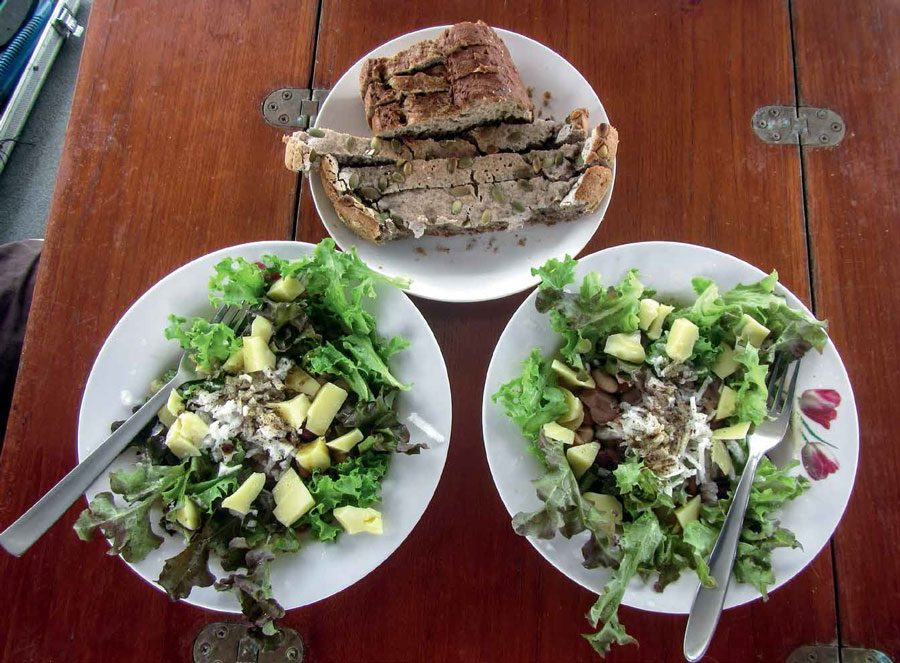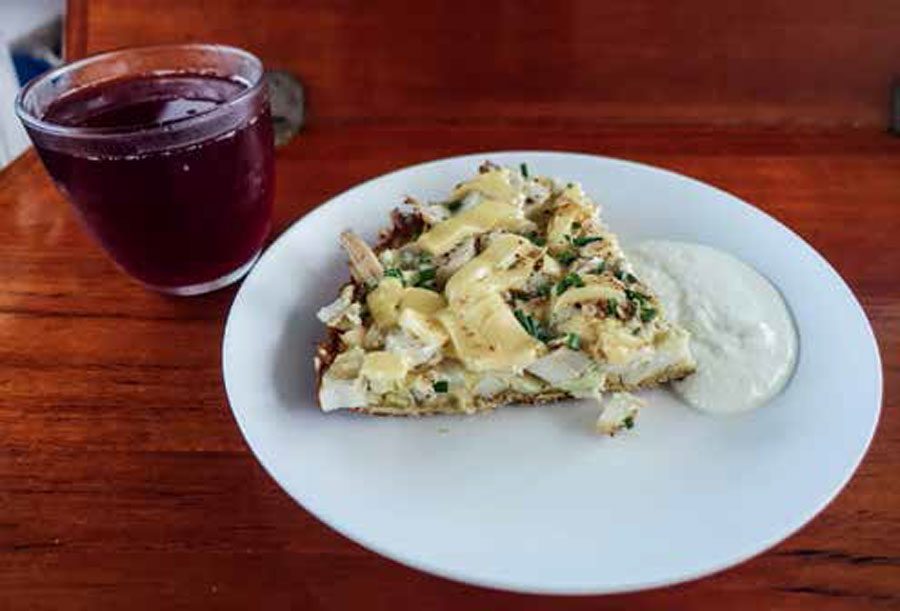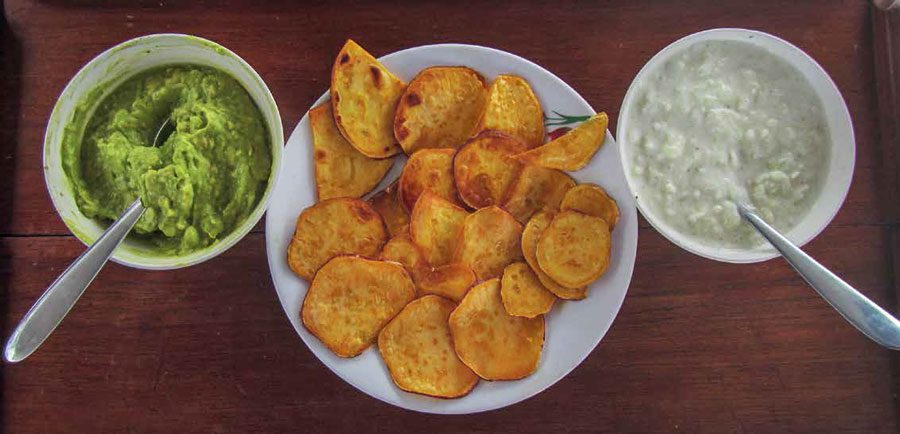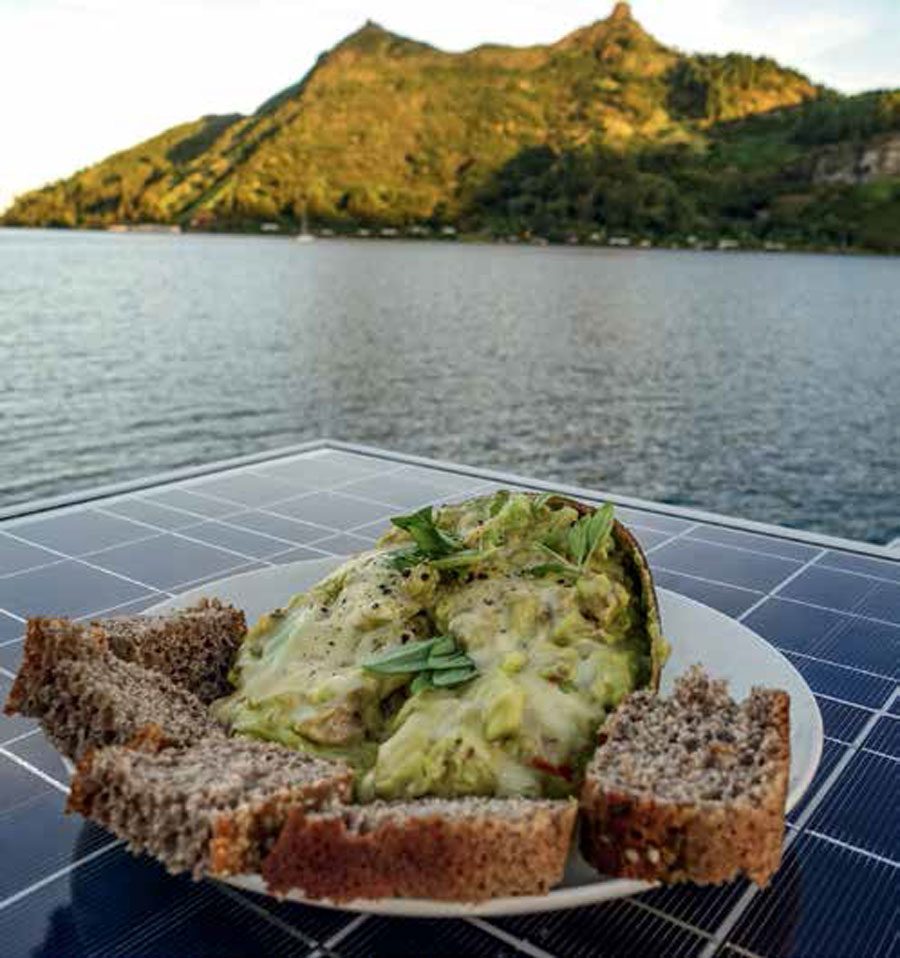

Tips for a gourmet galley in remote places–simplifying and substituting is the key!
On Pitufa we often have elaborate gourmet meals, even though we only have a tiny galley and an elderly kerosene stove with lots of character (politely put!) and usually just one burner in working condition.
To create even more of a challenge, we enjoy extended cruising in areas with either tiny minimarkets or no markets at all, so we can’t just look up a fancy recipe and pop by the store to grab all required ingredients. Out of necessity, I started experimenting creatively with local produce and found that creating adventurous fusion food is much more fun than just following a recipe.

Our menu plan usually starts with me going through our provisioning lockers and the depths of our extensive fridge. “Cooking ahead of decay” is the motto and whatever veg is starting to look tired will feature in the day’s meal.
The next question is: What country do we feel like? Today’s slightly wobbly eggplant could hop into a sauce for Italian pasta, an Indian vindaloo curry, a Greek moussaka, a Chinese stir-fry, Vietnamese spring rolls, a Moroccan-style stew, or a dish from whatever other region our taste buds suggest. Of course, we never have all the ingredients a regular recipe would demand, but with a well-stocked spice rack and some creative substituting, my ingredients can be presented in a wide array of dishes.
No potatoes left? All kinds of starchy roots and veg can take their part: manioc (also known as yucca or cassava), yams or breadfruit, once boiled, can be used just like potatoes. They are great in fritters, a salad, mashed, stewed, used in frittatas, or even in a Spanish-style tortilla. Sweet potatoes add a sweetish touch to all those dishes but work just as well as regular potatoes (or even better).

No more lettuce in the fridge? Chinese cabbage tends to be more widely available on little islands as it is easy to grow and produces lots of biomass in a very short time. That makes it ideal to grow in pots on the boat! The green leaves of Chinese cabbage (pak-choy, bok-choy, po-ta – the names vary from region to region) are great in salads, while the white stems can pose as an asparagus replacement in pasta or risotto recipes.
Green papaya is the chameleon of the fruit/veg family and tends to be available even in places where nothing else is grown or imported! It has a very neutral taste and a firm texture, so it takes on the flavour of the dish it is used in.
It can be anything between crunchy (raw or quickly fried) and soft (boiled). Grated, it can substitute for cucumber in a Greek-style tzatziki yoghurt, or for carrots in a salad; cut into slices it’ll readily pose as bamboo shoots in a Chinese stir-fry, while boiled in a risotto, it can replace courgettes or pumpkin. Pickled, it can be a gherkin in disguise!
I know what I’m talking about, we once spent a few winter months in the Gambier Islands (French Polynesia), where nothing but bananas and papaya was locally available. The next time around it was avocado season – we had to use up at least two baseball-sized specimens per day. We ate guacamole, baked avocado and savoury avocado pies to avoid wasting any of the tasty bounty.

Even in the remotest tropical corners there are usually plenty of palm trees growing. Upon hacking down a two-metre tree you’ll find an amazing amount of heart of palm in the lower stem that has lots of vitamins and great nutritional value. Marinated in lemon and olive oil, it makes a nice salad, but it’s also good in stir-fries and other dishes.
It’s of course hard work to harvest but worth the effort – just make sure that the palm tree you’re murdering is really growing wild and not part of somebody’s garden!
We don’t have a freezer to store meat, and as a pescatarian I’m unwilling to cook it anyway, but I’ve found that red meat fish (e.g. bonito/skipjack tuna) can be used in many traditional meat recipes. Breaded it can pose as an Austrian Wiener schnitzel and thrown into a hearty paprika stew, it makes a goulash few Hungarians could resist.
Soy flakes (TSP) are another lightweight and easy-to-store alternative when you’re out of meat or trying to replace it with something else for a healthier lifestyle. Soaked in water first and then boiled in a pasta sauce or stew, these flskes will trick diehard meat eaters into enjoying a vegetarian dish.

We have a few cookbooks on Pitufa, but I usually take a look at the picture and just browse ingredients and the cooking instructions. Then I close the book and ponder how I could achieve a similar result with whatever is available on board. Then, with picture and taste in mind, I start cooking and keep on tasting and adding until I’ve got the desired result.
The fact that I’m a pescatarian and that my partner Christian tries to live gluten-free doesn’t slow me down, so don’t worry about going cruising if you have dietary issues. If there’s no gluten-free pasta available (or egg-free or dairy-free, or whatever-free your body desires), why not make lasagna with layers of finely cut breadfruit or taro instead?
If you’re allergic to dairy, why not substitute coconut milk for milk in your favorite recipes. That’s better than storing boxes of expensive (and perishable) almond milk on the boat. The key to gourmet dishes in remote places is to free yourself of restrictive recipes and to go wild with fusion food! BNZ

Birgit and Christian have been cooking their way around the world from Europe to the South Pacific aboard their S&S 41 Pitufa. Find out more about their journey on www.pitufa.at or read their book Sailing Towards the Horizon.




